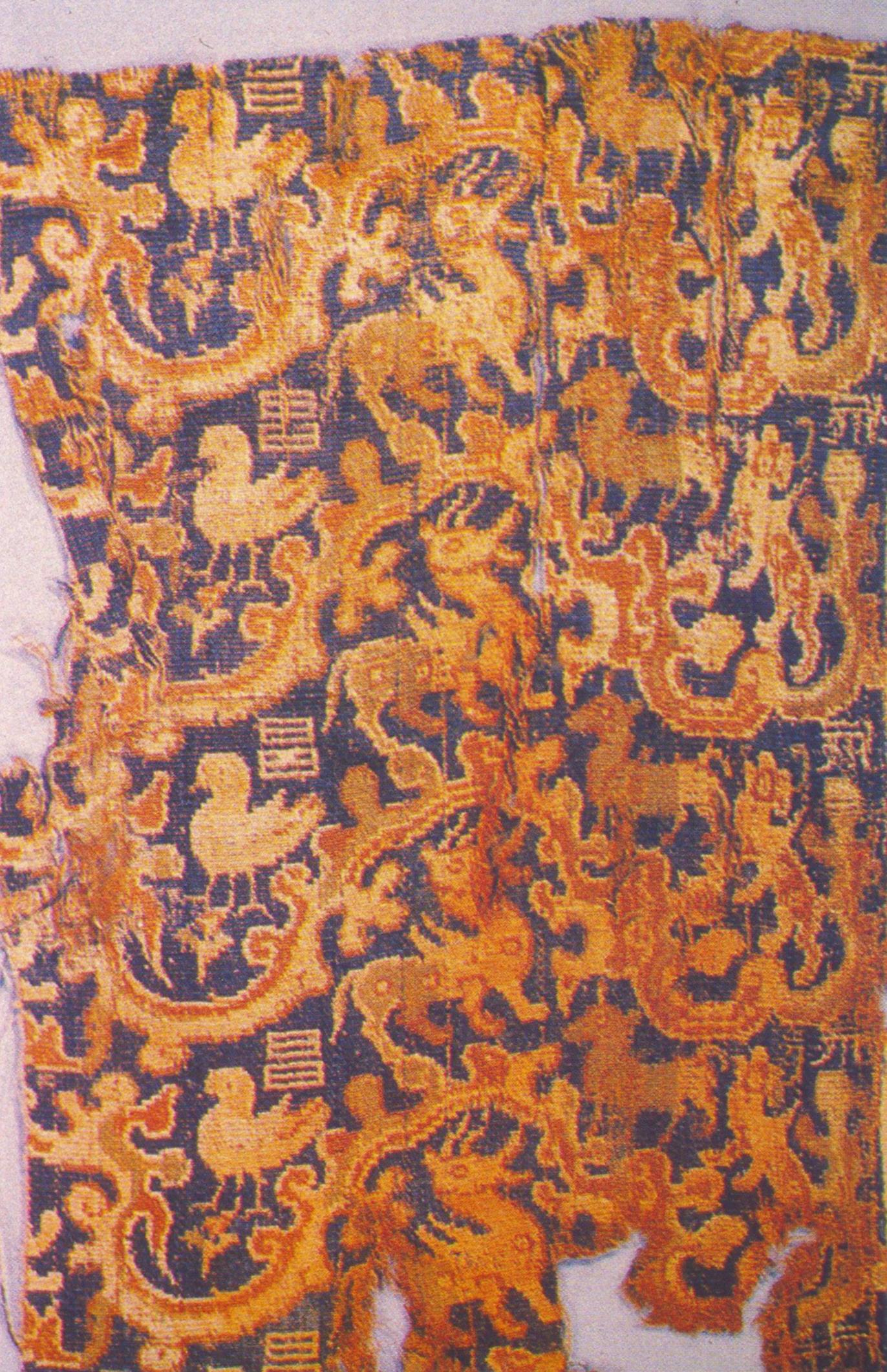|
Charkilik
Ruoqiang Town zh, c= , p=Ruòqiāng; Uyghur: Чакилик: Qakilik or Charklik is a town in Ruoqiang County, Bayin'gholin Mongol Autonomous Prefecture in southeastern Xinjiang, People's Republic of China. Ruoqiang Town is the county seat of the Ruoqiang County, and therefore is the place that less detailed maps label as "Ruoqiang County" or just "Ruoqiang". The postal code is 841 800. There is a two-laned asphalt highway to Korla, north, and west to Hotan. There is no motorable road east to Dunhuang in Gansu, but one can now drive southeast through the Altun Shan range and then north through part of the Tsaidam to Dunhuang. Names Lionel Giles has recorded the following names for Ruoqiang Town (with his Wade-Giles forms of the Chinese names converted to pinyin): :"''Yixun'', or Yixiu, capital of Shanshan after 77 B.C. (Note: This is an incorrect identification, the capital's name was, in fact, Yüni 扜泥.) :Shanshan Zhen ui :Nafubo (纳缚波) uanzang :Dianhe ang : ... [...More Info...] [...Related Items...] OR: [Wikipedia] [Google] [Baidu] |
Town (China)
When referring to Administrative divisions of China#Township level (4th), political divisions of China, town is the standard English translation of the Chinese (traditional: ; zh, p=zhèn , w=chen4). The Constitution of the People's Republic of China classifies towns as fourth-level administrative units, along with, for example, Townships of China, townships ( zh, s=乡 , p=xiāng). A township is typically smaller in population and more remote than a town. Similar to higher-level administrative units, the borders of a town would typically include an urban core (a small town with the population on the order of 10,000 people), as well as a rural area with some Villages of China, villages ( zh, labels=no, s=村 , p=cūn, or zh, labels=no, s=庄 , p=zhuāng). Map representation A typical provincial map would merely show a town as a circle centered at its urban area and labeled with its name, while a more detailed one (e.g., a map of a single county-level division) would also s ... [...More Info...] [...Related Items...] OR: [Wikipedia] [Google] [Baidu] |
Gansu
Gansu is a provinces of China, province in Northwestern China. Its capital and largest city is Lanzhou, in the southeastern part of the province. The seventh-largest administrative district by area at , Gansu lies between the Tibetan Plateau, Tibetan and Loess Plateau, Loess plateaus and borders Mongolia's Govi-Altai Province, Inner Mongolia and Ningxia to the north, Xinjiang and Qinghai to the west, Sichuan to the south and Shaanxi to the east. The Yellow River passes through the southern part of the province. Part of Gansu's territory is located in the Gobi Desert. The Qilian Mountains, Qilian mountains are located in the south of the Province. Gansu has a population of 26 million, ranking List of Chinese administrative divisions by population, 22nd in China. Its population is mostly Han Chinese, Han, along with Hui people, Hui, Dongxiangs, Dongxiang and Tibetan people, Tibetan minorities. The most common language is Mandarin. Gansu is among the poorest administrative divi ... [...More Info...] [...Related Items...] OR: [Wikipedia] [Google] [Baidu] |
Loulan Museum, Charklik
Loulan ( zh, t=, p=Lóulán < Eastern Han Chinese ''lo-lɑn'' < Old Chinese ''rô-rân''), also known as Kroraïna () in native Gandhari language, Gandhari documents or Krorän in later Uyghur (), was an ancient kingdom based around an important oasis city along the Silk Road already known in the 2nd century BCE on the northeastern edge of the Lop Desert. The term Loulan is the Chinese transcription of the native name Kroraïna and is used to refer to the city near the brackish desert lake Lop Nur as well as the kingdom. The kingdom was renamed Shanshan (wikt:鄯善, 鄯善) after its king was assassinated by an envoy of the Han dynasty in 77 BCE; however, the town at the northwestern corner of Lop Nur retained the name of Loulan. The kingdom included at various times settlements such as Niya ruins, Niya, Charklik (ancient settlement), Charklik, Miran (Xinjiang), Miran and Qiemo Town, Qiemo. It was intermittently under Chinese control from the ear ... [...More Info...] [...Related Items...] OR: [Wikipedia] [Google] [Baidu] |
National Bureau Of Statistics Of The People's Republic Of China
The National Bureau of Statistics () is a deputy-ministerial level agency directly under the State Council of China. Established in August 1952, the bureau is responsible for collection, investigation, research and publication of statistics concerning the nation's economy, population and other aspects of the society. Kang Yi has served as the commissioner of the bureau since 3 March 2022. Responsibilities The bureau's authority and responsibilities are defined in ''Statistics Law of the People's Republic of China''. It is responsible for the research of the nation's overall statistics and oversees the operations of its local counterparts. Organizations The bureau is overseen by a commissioner, several deputy commissioners (currently four), a chief methodologist, a chief economist, and a chief information officer. It is composed of 18 departments, oversees 12 affiliated institutions, and manages 32 survey organizations stationed in respective provinces. It also operates ... [...More Info...] [...Related Items...] OR: [Wikipedia] [Google] [Baidu] |
Residential Community
A residential community is a community, usually a small town or city, that is composed mostly of residents, as opposed to commercial businesses and/or industrial facilities, all three of which are considered to be the three main types of occupants of the typical community. Residential communities are typically communities that help support more commercial or industrial communities with consumers and workers. That phenomenon is probably because some people prefer not to live in an urban or industrial area, but rather a suburban or rural setting. For that reason, they are also called dormitory towns, bedroom communities, or commuter towns. An example of residential community would include a small town or city outside a larger city or a large town located near a smaller but more commercially- or industrially-centered town or city, for instance Taitou in Gaocun, Wuqing, and Tianjin, China. China In the People's Republic of China, a community ( zh, s=社区, la ... [...More Info...] [...Related Items...] OR: [Wikipedia] [Google] [Baidu] |
Shanshan
Shanshan (; ) was a kingdom located at the north-eastern end of the Taklamakan Desert near the great, but now mostly dry, salt lake known as Lop Nur. The kingdom was originally an independent city-state, known in local Gandhari documents as '' Kroraïna'' (Krorayina, Kröran) – which is commonly rendered in Chinese as ''Loulan''. The Western Han dynasty took direct control of the kingdom some time after 77 BCE, and it was later known in Chinese as Shanshan. The archaeologist J. P. Mallory has suggested that the name Shanshan may be derived from the name of another city in the area, '' Cherchen'' (later known in Chinese as ''Qiemo''). A local variety of Gandhari was used in the kingdom for administrative, literary, and epigraphic purposes. Scholars such as Thomas Burrow have suggested the local population might have spoke a hypothetical Tocharian C, as evidenced by the loanwords in those Gandhari documents. Location The kingdom of Kroraïna (Loulan), later Shanshan, was pro ... [...More Info...] [...Related Items...] OR: [Wikipedia] [Google] [Baidu] |
Eastern Han Dynasty
The Han dynasty was an Dynasties of China, imperial dynasty of China (202 BC9 AD, 25–220 AD) established by Liu Bang and ruled by the House of Liu. The dynasty was preceded by the short-lived Qin dynasty (221–206 BC) and a warring interregnum known as the Chu–Han Contention (206–202 BC), and it was succeeded by the Three Kingdoms period (220–280 AD). The dynasty was briefly interrupted by the Xin dynasty (9–23 AD) established by the usurping regent Wang Mang, and is thus separated into two periods—the #Western Han (202 BC – 9 AD), Western Han (202 BC9 AD) and the #Eastern Han (25–220 AD), Eastern Han (25–220 AD). Spanning over four centuries, the Han dynasty is considered a Golden ages of China, golden age in Chinese history, and had a permanent impact on Chinese identity in later periods. The majority ethnic group of modern China refer to themselves as the "Han people" or "Han Chinese". The spoken Chinese ... [...More Info...] [...Related Items...] OR: [Wikipedia] [Google] [Baidu] |
Former Han
The Han dynasty was an imperial dynasty of China (202 BC9 AD, 25–220 AD) established by Liu Bang and ruled by the House of Liu. The dynasty was preceded by the short-lived Qin dynasty (221–206 BC) and a warring interregnum known as the Chu–Han Contention (206–202 BC), and it was succeeded by the Three Kingdoms period (220–280 AD). The dynasty was briefly interrupted by the Xin dynasty (9–23 AD) established by the usurping regent Wang Mang, and is thus separated into two periods—the Western Han (202 BC9 AD) and the Eastern Han (25–220 AD). Spanning over four centuries, the Han dynasty is considered a golden age in Chinese history, and had a permanent impact on Chinese identity in later periods. The majority ethnic group of modern China refer to themselves as the " Han people" or "Han Chinese". The spoken Chinese and written Chinese are referred to respectively as the "Han language" and " Han characters". ... [...More Info...] [...Related Items...] OR: [Wikipedia] [Google] [Baidu] |
Couple Selling Jade In Charklik
Couple or couples may refer to: *Couple, a set of two of items of a type *Couple (mechanics), a pair of force which are equal in magnitude but opposite in direction and separated by a perpendicular distance so that their line of action do not coincide that cause a turning effect *Couple (relationship), two people in an intimate relationship Arts and entertainment * ''Couples'' (novel), by John Updike, 1968 * "Couples" (''Duty Free''), a 1984 television episode Films * ''Couples'' (2011 film), a South Korean film * ''Couples'' (1999 film), a Spanish comedy film *''Couples'', a 1994 American television film directed by Betty Thomas *'' The Aryan Couple'', a 2004 drama film released in the U.S. as ''The Couple'' *'' A Couple'', 2022 French film Music *''Couple'', a 2004 album by Kim Yeon-woo * ''Couples'' (Pizzicato Five album), 1987 * ''Couples'' (The Long Blondes album), 2008 *"Couples", a song by Pizzicato Five from the 1998 album ''Bellissima!'' *Le Couple, a Japanese band ... [...More Info...] [...Related Items...] OR: [Wikipedia] [Google] [Baidu] |
Pinyin
Hanyu Pinyin, or simply pinyin, officially the Chinese Phonetic Alphabet, is the most common romanization system for Standard Chinese. ''Hanyu'' () literally means 'Han Chinese, Han language'—that is, the Chinese language—while ''pinyin'' literally means 'spelled sounds'. Pinyin is the official romanization system used in China, Singapore, Taiwan, and by the United Nations. Its use has become common when transliterating Standard Chinese mostly regardless of region, though it is less ubiquitous in Taiwan. It is used to teach Standard Chinese, normally written with Chinese characters, to students in mainland China and Singapore. Pinyin is also used by various Chinese input method, input methods on computers and to lexicographic ordering, categorize entries in some Chinese dictionaries. In pinyin, each Chinese syllable is spelled in terms of an optional initial (linguistics), initial and a final (linguistics), final, each of which is represented by one or more letters. Initi ... [...More Info...] [...Related Items...] OR: [Wikipedia] [Google] [Baidu] |






